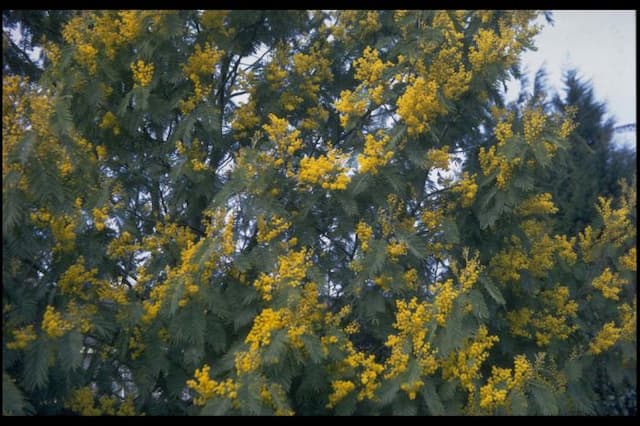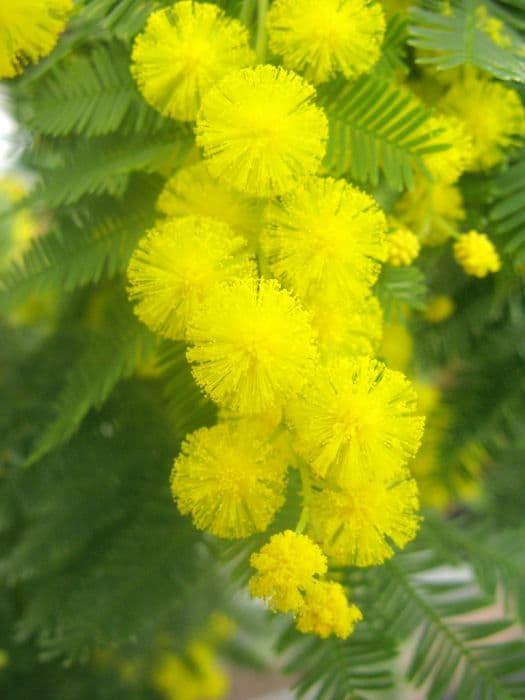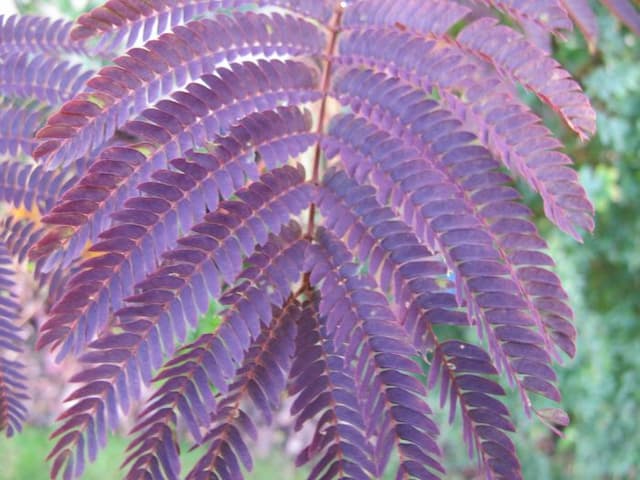Golden Pea Lathyrus aureus

ABOUT
The plant known as golden pea showcases a stunning visual appeal that is often admired in gardens and natural settings. Characterized by its striking flowers which typically bloom in striking shades of yellow, these blooms exude a bright, sun-kissed vibe. The flowers are reminiscent in shape to those of the common pea, boasting a charming butterfly-like form known as a 'keel', fused with 'wings' and a 'banner', which contributes to their ornamental value. The foliage of the golden pea consists of slender leaves that are divided into multiple leaflets. The overall leaf structure is feather-like, contributing to an airy and delicate texture in the plant's profile. The leaves typically come in various shades of green, which perfectly complement the golden flowers and enhance their vibrancy. The stems of the golden pea, which provide support for the flowers and leaves, are typically thin and wiry. They add to the overall elegance and grace of the plant's structure. This plant's appearance can vary and evolve through the seasons, offering different aspects of its beauty at different times of the year.
About this plant
 Names
NamesFamily
Fabaceae
Synonyms
Golden Pea, Tom Thumb
Common names
Orobus aureus
 Toxicity
ToxicityTo humans
Lathyrus aureus, commonly referred to as golden pea, is known to contain a toxin that can cause a condition known as lathyrism if ingested. This toxin affects the nervous system and can lead to paralysis and potentially irreversible neurotoxic effects. Symptoms of lathyrism can include muscle weakness, difficulty walking, and paralysis of the lower limbs. Chronic ingestion can result in more severe neurological disorders or even permanent damage. It is crucial to avoid consuming any part of the golden pea to prevent the risk of poisoning.
To pets
Golden pea or Lathyrus aureus can also be toxic to pets if ingested. The plant contains the same neurotoxic compounds that cause lathyrism in humans, and these can similarly affect animals. Symptoms of poisoning in pets may include vomiting, lethargy, seizures, and muscle tremors. In severe cases, paralysis and permanent neurological damage are potential consequences. It is important for pet owners to ensure that their animals do not eat any part of the golden pea plant to avoid the risk of toxicity.
 Characteristics
CharacteristicsLife cycle
Perennials
Foliage type
Deciduous
Color of leaves
Green
Flower color
Yellow
Height
3 feet (91 cm)
Spread
1 foot (30 cm)
Plant type
Climber
Hardiness zones
Varies
Native area
Mediterranean
Benefits
 General Benefits
General Benefits- Decorative Value: Adds aesthetic appeal to gardens with bright yellow flowers.
- Nitrogen Fixation: Improves soil fertility by fixing atmospheric nitrogen.
- Wildlife Habitat: Provides shelter and food for various insects and animals.
- Pollinator Attraction: Attracts bees and butterflies, aiding in pollination of nearby plants.
- Erosion Control: Helps stabilize soil and prevent erosion with its root system.
 Medical Properties
Medical PropertiesThis plant is not used for medical purposes.
 Air-purifying Qualities
Air-purifying QualitiesThis plant is not specifically known for air purifying qualities.
 Other Uses
Other Uses- Lathyrus aureus, commonly known as Golden Pea, has been used in traditional fabric dyeing practices for imparting a yellow hue, utilizing the flowers which contain natural pigments.
- The stems and foliage of Golden Pea can be woven into small crafts or decorations, taking advantage of their natural flexibility and strength when freshly harvested.
- Golden Pea can serve as a natural insect repellent in gardens, as some pests are deterred by the compounds found in the plant.
- The flowers of Golden Pea make for attractive additions to wildflower bouquets, providing a splash of color that is both natural and long-lasting.
- In educational settings, Golden Pea can be used for biology experiments, such as studying plant growth, pollination, and nitrogen fixation.
- Seed pods from Golden Pea can be used for craft projects, such as making rattles or other sound-producing toys, when dried and filled with small pebbles.
- As a nitrogen-fixing plant, Golden Pea can be used in crop rotation or intercropping to improve soil fertility naturally.
- Dried Golden Pea plants can be used as filling material for eco-friendly packaging or as an organic mulch in gardening to suppress weeds.
- Golden Pea's vines can be trained to grow over unsightly structures, providing a quick and attractive green cover that can enhance the overall aesthetics of an area.
- The dense foliage of Golden Pea can be utilized as habitat enhancement in gardens, offering shelter to beneficial insects and small wildlife.
Interesting Facts
 Feng Shui
Feng ShuiThe plant Lathyrus aureus, commonly known as golden pea, is not used in Feng Shui practice.
 Zodiac Sign Compitability
Zodiac Sign CompitabilityThe golden pea is not used in astrology practice.
 Plant Symbolism
Plant Symbolism- Prosperity: The "aureus" in Lathyrus aureus literally means "golden," which is traditionally associated with wealth and prosperity.
- Blissful Pleasure: As a member of the sweet pea family, the fragrance and delicate beauty of these flowers are often linked to the pure enjoyment and pleasure in life.
- Lasting Pleasure: Lathyrus aureus, like other sweet peas, is typically seen as symbolizing pleasure that is not transient, but lasting and remembered.
- Departure: Sweet peas have historically been associated with goodbyes or the end of a pleasurable time, which ties in with their use in farewells.
- Gratitude: The gift of a sweet pea flower is often meant to express thanks, possibly due to the joy its presence brings.
 Water
WaterGolden Pea should be watered regularly to maintain evenly moist soil, especially during its growth phase in the spring and early summer. Generally, this means soaking the soil around the roots until the water starts to run through the drainage holes in the pot, which could be around a gallon every week for an average-sized plant, depending on the weather and soil type. In warmer temperatures or windy conditions, you may need to water more frequently. Always check the top inch of soil for dryness before watering again; Golden Pea doesn't like to be waterlogged. Decrease watering in the fall and winter when the plant's growth slows down.
 Light
LightGolden Pea plants thrive in full sun to partial shade. The best spot would be a location where the plant can receive at least six hours of direct sunlight each day, with some dappled shade during the hottest part of the afternoon. East or west-facing locations are ideal for providing the optimal light conditions Golden Pea needs to flourish.
 Temperature
TemperatureGolden Pea prefers a temperate climate with temperatures ranging between 50 to 75 degrees Fahrenheit. The plant can tolerate a minimum temperature of around 20 degrees Fahrenheit, but frost can be damaging, so it should be protected or brought indoors if temperatures dip lower. The ideal temperature range for promoting vigorous growth in Golden Pea is generally between 60 to 70 degrees Fahrenheit.
 Pruning
PruningGolden Pea should be pruned to stimulate bushier growth, remove dead or diseased foliage, and encourage blooming. Pruning is best done in late winter or early spring before new growth begins. You can cut back the previous year's growth by about one-third to maintain shape and health. Deadheading, or the removal of spent flowers, can be done throughout the blooming period to promote further flowering.
 Cleaning
CleaningAs needed
 Soil
SoilGolden Pea thrives in well-draining soil with a neutral to slightly alkaline pH, typically around 7.0 to 7.5. A good soil mix can be made from garden soil, compost, and perlite or sand to improve drainage. Regularly check soil pH and adjust with lime to maintain an alkaline condition.
 Repotting
RepottingGolden Pea does not typically require frequent repotting and can do well if repotted every 2-3 years. However, monitor the root growth and repot if the plant becomes root-bound or the soil quality degrades.
 Humidity & Misting
Humidity & MistingGolden Pea prefers moderate humidity levels, maintaining an environment that is not overly dry. A humidity level of 40-60% is ideal for this plant.
 Suitable locations
Suitable locationsIndoor
Provide bright light, well-draining soil, and moderate water.
Outdoor
Plant in full sun to partial shade, in well-draining soil.
Hardiness zone
5-9 USDA
 Life cycle
Life cycleLathyrus aureus, commonly known as golden pea, begins its life cycle as a seed, which, under appropriate conditions of moisture and temperature, will germinate to produce a small seedling. The seedling emerges from the soil and develops true leaves, transitioning into the vegetative growth phase where the plant grows in size and strength. Following vegetative growth, the golden pea enters the reproductive stage, characterized by the development of flowers that are typically bright yellow, attracting pollinators for fertilization. After successful pollination, the flowers give way to legume pods, each containing seeds. The pods mature and eventually dry out, releasing the seeds into the environment. This completes the life cycle as the new seeds are now ready to germinate and grow into new golden pea plants, continuing the cycle.
 Propogation
PropogationPropogation time
Spring
Lathyrus aureus, commonly known as the golden pea, is typically propagated through seed sowing. The most favorable time for sowing its seeds is in late winter or early spring. To propagate by seeds, initially, it's advisable to nick or slightly file the seed coat to facilitate water absorption, a process known as scarification. Then, seeds should be soaked in water for 24 hours to further soften the coat and promote germination. Sow the seeds about a half inch deep (approximately 1.27 centimeters) in well-draining soil and space them a couple of inches apart. In optimal conditions, germination will occur within 2 to 3 weeks. Once seedlings are large enough to handle, they can be transplanted to their final growing location, ensuring they are supported as they grow, since Lathyrus aureus is a climbing plant.









